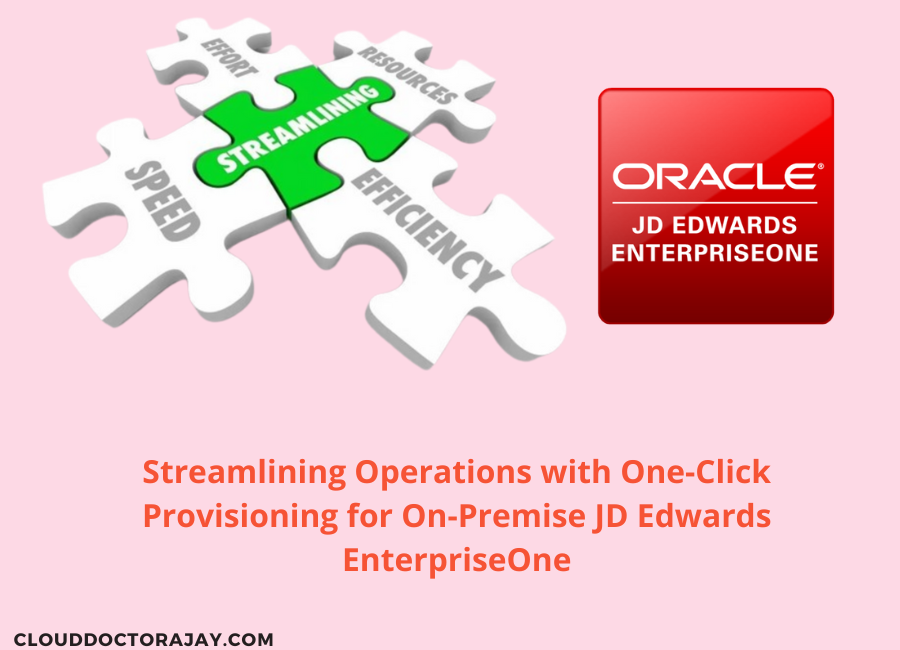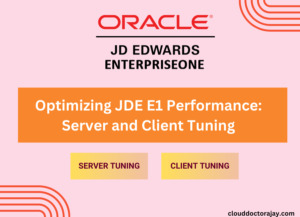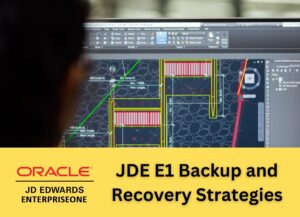Introduction
In the fast-paced world of enterprise resource planning (ERP), businesses are constantly seeking ways to enhance efficiency, reduce costs, and streamline their operations. One-click provisioning has emerged as a game-changer, particularly for on-premise installations of JD Edwards EnterpriseOne.
This innovative approach to provisioning not only accelerates the deployment process but also simplifies the management of the ERP system, ultimately empowering organizations to focus more on their core business objectives.
Understanding On-Premise JD Edwards EnterpriseOne
JD Edwards EnterpriseOne is a robust and comprehensive ERP solution that helps businesses manage their financials, supply chain, manufacturing, and human resources, among other critical functions.
While cloud-based solutions are gaining popularity, many enterprises still prefer on-premise installations for reasons such as data sovereignty, compliance, and control over the IT infrastructure.
However, managing and provisioning an on-premise JD Edwards EnterpriseOne system traditionally involves a complex and time-consuming process. This is where one-click provisioning steps in to revolutionize the way businesses handle their ERP deployments.
The Power of One-Click Provisioning
One-click provisioning refers to the automation of the entire provisioning process for JD Edwards EnterpriseOne, from installation to configuration. This approach significantly reduces the manual effort and time traditionally required for provisioning, offering businesses a rapid and seamless deployment experience.
JDE E1 Backup and Recovery Strategies: Ensuring Data Security and Business Continuity
Benefits of One-Click Provisioning for On-Premise JD Edwards EnterpriseOne
1. Speedy Deployment:
One-click provisioning accelerates the deployment process, allowing businesses to set up their JD Edwards EnterpriseOne instances in a fraction of the time compared to traditional methods. This speed is crucial in today’s dynamic business environment, where agility and responsiveness are key to staying competitive.
2. Reduced Complexity:
Traditional ERP deployments often involve intricate steps and manual configurations, leading to a higher likelihood of errors. One-click provisioning simplifies the process by automating these steps, reducing the complexity associated with installation and configuration. This not only minimizes the risk of errors but also makes the entire deployment more accessible to IT teams with varying skill levels.
3. Resource Optimization:
Automation inherent in one-click provisioning translates to resource optimization. IT teams can allocate their time and skills more efficiently, focusing on strategic initiatives rather than getting bogged down by routine and time-consuming provisioning tasks.
4. Consistency Across Environments:
One-click provisioning ensures consistency across different environments, from development and testing to production. This consistency is vital for maintaining the integrity of the ERP system and minimizing the chances of discrepancies that could arise from manual interventions.
5. Scalability:
As businesses grow, the demand for scalable solutions becomes imperative. One-click provisioning facilitates easy scalability, allowing organizations to expand their JD Edwards EnterpriseOne footprint without encountering the logistical challenges typically associated with scaling on-premise systems.
6. Cost Savings:
The efficiency gained through one-click provisioning translates into cost savings. By reducing the time and effort required for deployment, organizations can cut down on labour costs and allocate resources more judiciously.
Implementation Considerations
While the benefits of one-click provisioning for on-premise JD Edwards EnterpriseOne are compelling, successful implementation requires careful consideration of several factors:
1. Infrastructure Readiness:
Ensure that the existing infrastructure meets the requirements for one-click provisioning. This may involve updating hardware, operating systems, and other dependencies to align with the automation process.
2. Security Protocols:
Security is a paramount concern in ERP systems. One-click provisioning solutions should adhere to robust security protocols to safeguard sensitive data during the deployment process.
3. Customization Requirements:
Businesses often have unique customization requirements for their JD Edwards EnterpriseOne installations. Ensure that the one-click provisioning solution supports the incorporation of these customizations seamlessly.
4. Training and Change Management:
Implementing one-click provisioning may necessitate training for IT teams to familiarize them with the new process. Additionally, change management strategies should be in place to ensure a smooth transition and acceptance of the automated provisioning approach.
Planning and Carrying Out JDE E1 Upgrades: A Smooth Journey
Conclusion
One-click provisioning is reshaping the landscape of on-premise JD Edwards EnterpriseOne deployments, offering businesses a faster, more efficient, and cost-effective way to manage their ERP systems.
As organizations strive to stay agile in an ever-evolving business landscape, the adoption of one-click provisioning becomes a strategic imperative, enabling them to focus on innovation and growth rather than getting bogged down by the complexities of ERP deployment.
By embracing this transformative approach, businesses can unlock the full potential of JD Edwards EnterpriseOne and position themselves for sustained success in the digital era.




